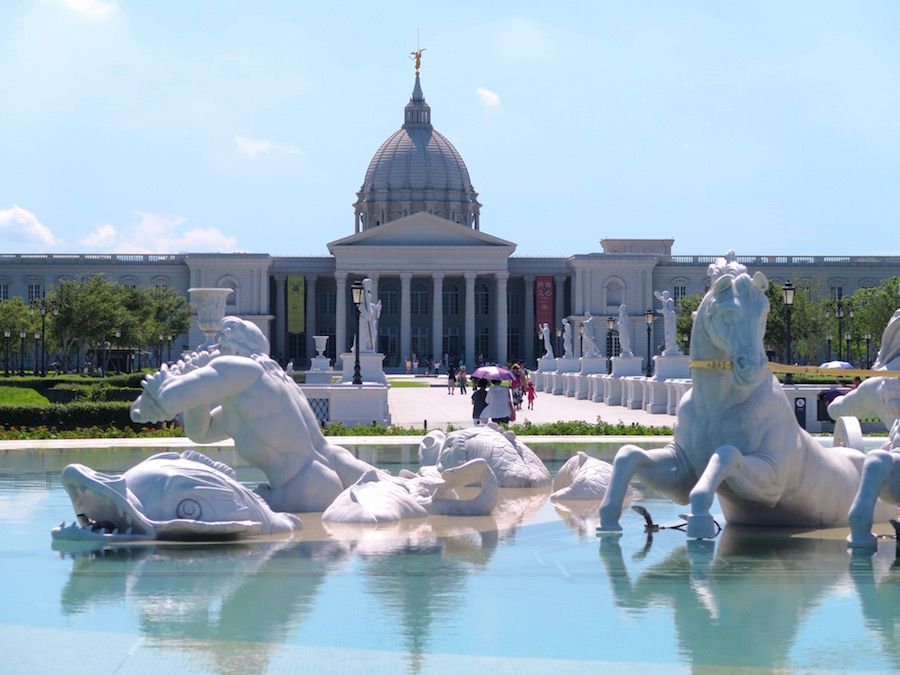On my trip to Taiwan in July, I visited the Chimei Museum in the southern city of Tainan. It houses a mixture of art, natural history and musical instruments. The museum was first established 1992 and since 2014 has been located within a large park with extensive buildings. The purpose of my visit to Chimei was first to see what instruments the museum had. From there, to see which instruments might be worth copying or to gather ideas to incorporate into my work in Ottawa. I had already copied one of the violins from the museum: the ‘Ole Bull’ Guarneri Del Gesu from 1744. My copy is now in the National Arts Centre Orchestra. But there was much more to see.
On my arrival I was warmly greeted by museum curator Mr Dai-Ting Chung. The collection has around 1,300 violins and as well as several hundred bows. It covers a wide range of violins, violas and cellos from many different countries and time periods. A portion of its collection is lent to fine Taiwanese string players to support their careers. Since it was my first visit I asked to focus on seeing their Italian instruments from Cremona and some other interesting instruments from Brescia, Mantua and Venice.
I began with the Amati family of violin makers, the founders of violin making. Below on the table are three Amati violins that I studied as a group. Also for comparison, an Andrea Guarneri violin, since he was a pupil and employee of Nicolò Amati in Cremona, Italy. It’s useful to see a group of instruments from the same maker or family of makers. At times a typical feature of their work can become quite obvious when seeing their work as a group.
Next were the Stradivari violins, which included the 1707 ‘Dushkin’, 1709 ‘Viotti’, a 1713 Stradivari, and the 1722 ‘Elman’ Stradivari violin. The ‘Viotti’ Stradivari is very similar to the other ‘Viotti’ Stradivari at the Royal Academy of Music in London, U.K., of the same year. Both with well figured one piece backs and a striking red varnish. The ‘Viott’ pictured below was a beautiful example of Stradivari’s work, with a high level of workmanship and a great choice of woods used.
Moving on from the Stradivari violins, for me one of the stars of the collection was a Carlo Bergonzi 1732 violin. Bergonzi was a colleague or perhaps an assistant of Stradivari working in Cremona in the first half the 18th Century. The varnish was well preserved, with much of the original texture and crackeleur intact. So often this detail has been polished away on older violins. While Bergonzi’s work clearly shows the influence of Stradivari, it was impressive to see that he was still able to develop his own fine style and not just copy Stradivari.
The collection had many great cellos in storage and in particular I looked at 5 Italian cellos. 2 Stradivari cellos: the 1709 ‘Boccherini’ and the 1730 ‘Pawle’. A Carlo Bergonzi cello from 1735. A later Cremonese cello by Storioni and a Venetian cello by Matteo Groffriller.
Above: One the left the 1730 ‘Pawle’ Stradivari cello and on the right the 1709 ‘Boccherini’ Stradivari cello.
The Stradivari cello from 1709 was made with his classic ‘B form’ design. Unfortunately a previous owner in the late 18th Century had the body of the cello cut down to reduce its size. Later a restorer increased the size by fitting in new wood. Together with some serious damage to the ribs and missing the original scroll, it has been badly treated during the last 308 years. But the other Stradivari from 1730 was in overall beautiful condition with large amounts of original varnish. It was made on a smaller design which is typical for the late period Stradivari cellos.
Above is a quick photo of the scroll of the 1730 ‘Pawle’ Stradivari cello.
All the instruments I’ve mentioned above were taken out from their vault. The permanent collection on display to the public also includes other Stradivari and Guarneri violins and so on. Below shows some of the public museum area.
My visit was short given the large size of the collection at the Chimei Museum. I photographed several instruments and took notes of my observations. It was great to have a general sense of what is in their collection and perhaps it will be a useful source for future study.





